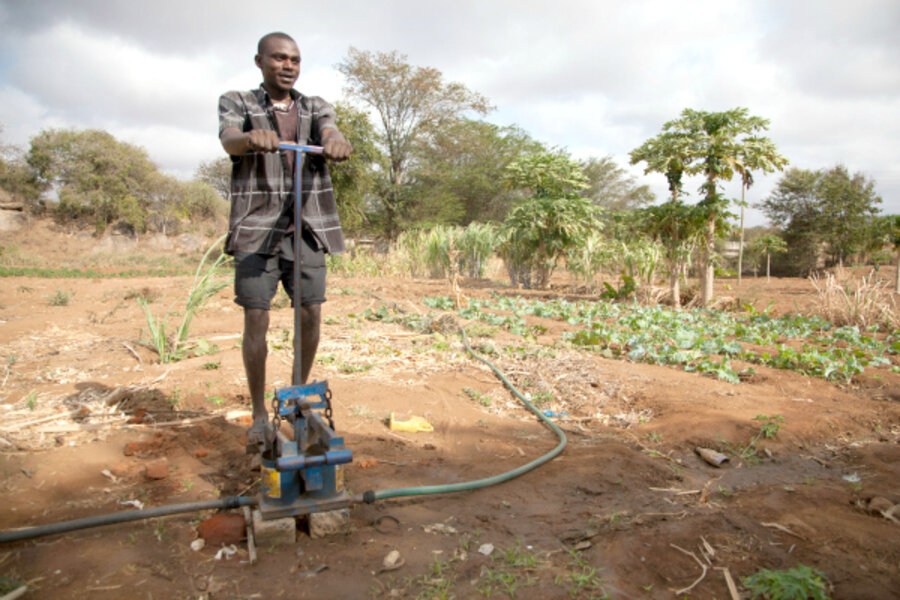Solar pumps could boost farm yields in poor countries
Loading...
A guest post by Paul Polak, author, “Out of Poverty,” and founder of International Development Enterprises:
What if we could harness the limitless power of the sun to carry water to the crops of millions of small poor farmers around the world?
If I want to water my petunias, I turn on the tap outside my house, hold my thumb over the end of a battered green hose, and water away.
If a small farmer in Ghana or China wants to water a small patch of vegetables he’s growing to sell in the local market, he breaks his back hauling water in two buckets or sprinkling cans from a nearby stream. It takes six hours a day every other day for three months to water a tenth of an acre of vegetables which might sell for $100 at the most.
The 1 billion of the world’s rural poor want out of poverty.
But to escape poverty they need to grow more cash crops to increase their income. The only way to grow more cash crops is to pump water. The current ways of doing it don’t work very well.
Foot pumps, diesel pumps, and solar pumps
A foot-operated pump that costs $25 will irrigate as much as half an acre with about four hours a day of work to earn a transformative $100 or more in profit. But it’s hard work, and anybody in his right mind would prefer to use a mechanized pump if he were able to afford it.
A five-horsepower diesel pump irrigates two-and-a-half acres of vegetables, but costs $350. And $450 a year for diesel [fuel], plus another $150 a year for repairs means $2,100 over the course of three years, not counting the cost of crop damage when the diesel pump requires repair.
It’s just too expensive for poor farmers.
But what if the same farmer could use a 2-kilowatt electric pump powered by solar photovoltaic panels instead? The fuel costs and operating costs would be close to zero, but there’s a big catch. It would cost about $7,000.
Most small farmers in Asia and Africa could never afford to buy an electric pump either.
What if we could find a way to cut the cost of a 2-kilowatt solar pump system from$7,000 to $2,500? And what if we added a $1,400, 2.5-acre low-cost drip system and used the solar pump/drip system to grow 2.5 acres of diversified off-season fruits, vegetables, and spices? If done correctly, farmers could clear at least $4,500.
That’s enough to make payments on a three-year loan or lease and make a profit.
SunWater
The SunWater project aims to achieve breakthrough affordability for photovoltaic pumping and irrigation, enabling small farmers all over the world to move out of poverty. Farmers using these pumps will also provide jobs for their neighbors to plant, weed, harvest, and market the crops they grow.
Today, 19 million diesel engines are being used to pump irrigation water from shallow wells in India alone, spewing millions of tons of carbon into the atmosphere. If marketplace forces could replace a quarter of them with radically affordable photovoltaic-powered pump systems, we could transform small farmer livelihoods and radically reduce rural carbon emissions.
The team is developing a two-kilowatt solar-powered pumping system that can do the same job as a five-horsepower diesel pump, the most commonly used size. We’re taking a whole-systems approach, for example, using mirrors to concentrate the sun and bring down the cost of the solar cell.
The pumped water cools the solar cells, which increases their efficiency. An inverter is hooked up so it can use AC pump motors, which are widely available and cheap. Then we tune the mirrors, solar cells, cooling system, and pump so that it gives the right output for the right cost.
These pumps only pump during the day, but they don’t use diesel fuel, and they rarely break down. The SunWater system also has very low operating costs compared to a diesel pump.
The system will cost $2,500 instead of $7,000, and when paired with a low-cost, efficient drip-irrigation system, a farmer can pay it off in two years. The quick payback time makes all the difference for those living in poverty. What’s more, once the system is paid off, there is no fuel to buy.
At this price, the solar pumping systems should fly off the shelves.
In India, the government has a 20 percent subsidy on these systems, so the cost for farmers is actually closer to $2,000.
SunWater will transform water pumping for farmers in developing nations by bringing electricity to a billion people who will never connect to the grid.
To learn more about SunWater technology, visit the team's Indiegogo SunWater site.
• This article originally appeared at Global Envision, a blog published by Mercy Corps.





